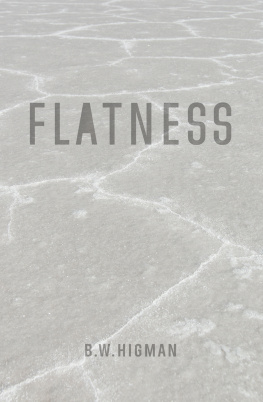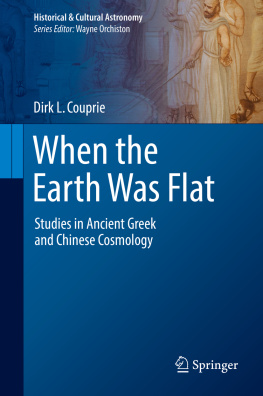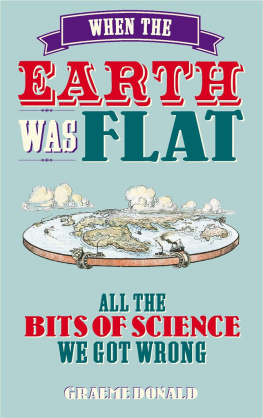Kaleb Shuttleworth - Planet or Plane?: A study of the ’Flat-Earth’ hypothesis.
Here you can read online Kaleb Shuttleworth - Planet or Plane?: A study of the ’Flat-Earth’ hypothesis. full text of the book (entire story) in english for free. Download pdf and epub, get meaning, cover and reviews about this ebook. year: 2018, genre: Children. Description of the work, (preface) as well as reviews are available. Best literature library LitArk.com created for fans of good reading and offers a wide selection of genres:
Romance novel
Science fiction
Adventure
Detective
Science
History
Home and family
Prose
Art
Politics
Computer
Non-fiction
Religion
Business
Children
Humor
Choose a favorite category and find really read worthwhile books. Enjoy immersion in the world of imagination, feel the emotions of the characters or learn something new for yourself, make an fascinating discovery.

- Book:Planet or Plane?: A study of the ’Flat-Earth’ hypothesis.
- Author:
- Genre:
- Year:2018
- Rating:4 / 5
- Favourites:Add to favourites
- Your mark:
- 80
- 1
- 2
- 3
- 4
- 5
Planet or Plane?: A study of the ’Flat-Earth’ hypothesis.: summary, description and annotation
We offer to read an annotation, description, summary or preface (depends on what the author of the book "Planet or Plane?: A study of the ’Flat-Earth’ hypothesis." wrote himself). If you haven't found the necessary information about the book — write in the comments, we will try to find it.
Planet or Plane?: A study of the ’Flat-Earth’ hypothesis. — read online for free the complete book (whole text) full work
Below is the text of the book, divided by pages. System saving the place of the last page read, allows you to conveniently read the book "Planet or Plane?: A study of the ’Flat-Earth’ hypothesis." online for free, without having to search again every time where you left off. Put a bookmark, and you can go to the page where you finished reading at any time.
Font size:
Interval:
Bookmark:
Planet or Plane?
An Unbiased Study of Flat-Earth Arguments
Welcome to the twenty-first century. Gravity doesn't exist, the Earth is flat, and if you think otherwise you're an utter fool! At least, according to a growing number of people. Like many others, Im frustrated with the lack of scientific literacy that seems to be plaguing our society, but what bothers me the most is the debate over the shape of the Earth.
In my frustration, Ive researched the topic and grouped together one hundred arguments supporting the flat-Earth hypothesis and shared what Ive learned about said arguments here. Now I'm sure you're expecting the how do people on the other side not fall off? argument, don't worry, it's coming. Even though I feel like I'm the idiot right now, because of the things I'm about to explain, there were a few arguments that I did find genuinely interesting and required research to refute, so I hope you'll learn something too.
I call this an unbiased study, but in reality, everyone has his or her own biases, including me. But in my defence, its hard not to be biased against a theory when the most commonly cited scientist, Dr. Samuel Rowbotham, proves himself wrong.
However, I am not only sharing the occasional biased opinion but over a hundred facts, the one thing that I know can never be biased. Although these facts may be proven wrong over time, as of now they are what is accepted as fact, to my knowledge anyway.
Now I know you're all thinking, Kaleb, shut up, because I'm thinking it too. So sit back, relax, and decide for yourself whether or not Antarctica is filled with armed NASA guards protecting a giant wall around the edge of the planet, that prevents the oceans from running off into space.
Argument One: All amateur footage shot without widescreen shows a flat horizon, even at over 20 miles in the air.
Rebuttal One: The problem with cameras is that they don't have the same field of view as the human eye, and widescreen would be necessary to take a picture of a noticeably curved horizon. People argue that widescreen causes distortion and the horizon only appears curved. However, curvature in the horizon is easily detected from a high enough altitude by the naked eye. Also, the only time ive heard of widescreen being a problem is during flat-Earth debates, and never on movie night.
Argument Two: While people claim to see the curvature of the planet through airplane windows, all airplane windows have been made curved to match the shape of the fuselage. This, combined with confirmation bias, causes people to falsely observe curvature of the planet. The fact that you can see the horizon at eye-level from 35,000 feet from both windows is proof of a flat-Earth, as you would need to look down to view the horizon.
Rebuttal Two: The curvature of an airplanes window is not enough to cause so much distortion, if it were the airport wouldnt appear to be square. Additionally, you cannot see the horizon at eye level from cruising altitude; this claim is not a fact, but an inaccurate observation. This can be easily proven with free apps on your smartphone, ones that use the phones built-in gyroscope to find true level. If youre like me and dont quite trust technology, bring a surveyors scope, which is a small ocular scope with a bubble level inside. While looking through the scope you are able to see exactly perpendicular.
Argument Three: Water would not be consistently flat throughout Earths movements.
Rebuttal Three: It is true that still water is consistently flat, but oceans prove otherwise, not only with their view of the horizon but also with their waves and currents. The Earths rotation plays a major part in ocean currents; this is a phenomenon called the Coriolis effect, which was popularized by a French scientist of the same name. The Coriolis effect also plays a large role in weather. Even when there's no wind to cause a ripple in a still lake, this is in part due to the Earths movements, but we'll get more into the weather aspect later on. What causes the Coriolis-Effect is the difference in Earths rotational speed between the equator and the poles. This phenomenon will be used to debunk later arguments.
Argument Four: If Earth were spinning some rivers would run upwards.
Rebuttal Four: Now this seems like a good argument, but some rivers do in fact run uphill, due to the force of Earths rotation. Sea level is not constant, and because the oceans bulge at the equator, all water flowing in its direction is fighting gravity with help from the centrifugal force of the planet.
Argument Five: Canals and bridges are laid out, sometimes over hundreds of miles, with no allowance for curvature.
Rebuttal Five: This is not entirely true. While most structures have no need to account for the curvature of Earth, at a certain scale, it does need to be taken into consideration. The Verrazano Narrows Bridge in New York City, at 13,700 feet long, was designed with the curvature of the planet in mind. Because the towers are 693 feet high, and 4,260 feet apart at the base, they are one and five-eighths of an inch further apart from each other at their tips.
Argument Six: The London and Northwestern Railway forms a straight 180-mile line, with the highest point at 240 feet above sea level. On a globe, the railway would form an arc rising 5,400 feet above London and Liverpool, peaking at Birmingham.
Rebuttal Six: The railway does indeed form an arc, in the same way the ground does. However, this would in no way alter Birmingham's height relative to sea level, nor it's height relative to London or Liverpool, if the highest point of the railway was 240 feet on a plane, its highest point would be equal on a sphere. While standing perpendicularly on the outside, or heel of an arc, at no point will any portion appear to rise upward.
Argument Seven: Factoring in the curvature of Earth for railroads is not required.
Rebuttal Seven: Factoring the curvature of the planet isnt required because the grade of the road is oriented to the ditch beside it. And I know this because Ive built roads professionally, and surveyed them myself on occasion. As for railroad tracks, theyre not square to each other, just close enough to be butt welded with thermite, afterwards, they are ground smooth.
Argument Eight: Experiments have shown that you can see lights across a distance that would be blocked by the curvature of the planet.
Rebuttal Eight: Not only could this be simple optical looming or another similar refraction in the atmosphere (like a Fata Morgana, which is caused by variations in air temperature that refract light near the viewers horizon), this could also be explained by light illuminating clouds or airborne particles. Never-the-less, this claim is unverified, presented with no supporting evidence, which makes it difficult to entertain.
Argument Nine: If the Earth was a sphere, planes would veer off into space by flying in a straight line, making the use of rockets unnecessary.
Rebuttal Nine: This is another example of an extreme misunderstanding of even the most basic scientific phenomenon. A regular airplane works by displacing air pressure along its wings, which means most planes would have no chance of even getting close to space. If you tried to bring a plane to space, you would eventually hit a point where it would continue to stall with attempts to go higher, due to the lack of air supply. Air is not only needed for combustion to occur, but to support the aircraft. A pilot constantly dipping downward to account for the curvature of the planet is absurd, as an aircrafts altitude wont rise without receiving more lift. Furthermore, aircrafts dont just fly straight; constant adjustments need to be made in order to maintain altitude and course. Try this: place a ruler on a table, and push it to the edge. Does the ruler amazingly remain horizontal until you push it completely off? Or does it dip down when theres not enough to support it?
Next pageFont size:
Interval:
Bookmark:
Similar books «Planet or Plane?: A study of the ’Flat-Earth’ hypothesis.»
Look at similar books to Planet or Plane?: A study of the ’Flat-Earth’ hypothesis.. We have selected literature similar in name and meaning in the hope of providing readers with more options to find new, interesting, not yet read works.
Discussion, reviews of the book Planet or Plane?: A study of the ’Flat-Earth’ hypothesis. and just readers' own opinions. Leave your comments, write what you think about the work, its meaning or the main characters. Specify what exactly you liked and what you didn't like, and why you think so.





